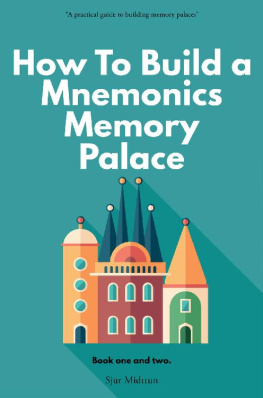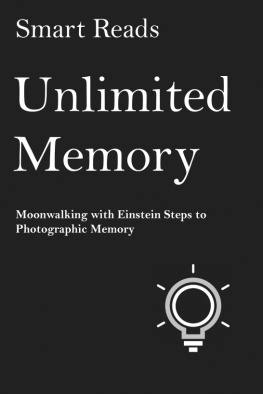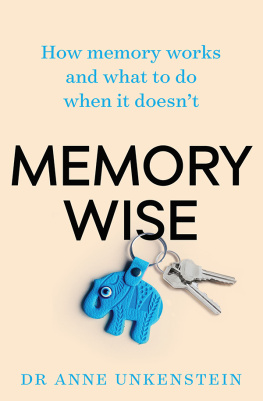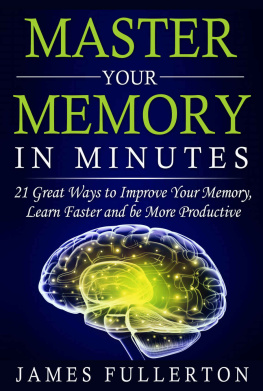Chapter one: Remembering is seeing
How good is your memory? If I asked you to take three to five minutes and memorize the following list of 20 objects, how many items would you be able to remember? Try it now, and see. Set aside three to five minutes, and memorize as many of these objects as possible, in sequence.
Fish , carpet , cigarette , p encil , h amburger , p hone , football , u mbrella , k ey , b eard , t ypewriter , c ar tire , dinner p late , ear , p illow , b oat , a pple tree , t oothbrush , n ecklace , a bottle of beer.
How did you do?
If youre like most people, you are probably able to memorize six or seven of these objects in sequence over the course of a few minutes. Most people are not able to memorize much more than nine objects, and virtually nobody more than ten.
One of the reasons is probably that most people memorize lists by repetition. By repeating the list (again and again and again), they manage to remember. Give them long enough time, and most people would be able to remember the whole list of 20 objects if they didnt give up because of boredom.
But with a time constraint of five minutes, the majority will only be able to memorize up to max ten objects.
Lets experiment.
Thinking differently about memorization
In the following five minutes you will learn how to memorize all these 20 objects in just five minutes or less, only looking over the list once. No repetition needed. The technique you will learn lies at the heart of traditional memory techniques, which are also called mnemonics.
But first - a word of caution. The system will involve absurdity. It will involve being silly. Memory techniques use silliness and absurdity for a reason. It gets results. So stay open-minded to the experiment. Follow these principles, the results will speak for themselves.
With this technique, you can memorize lists of 20, 50, 100 in fact as many objects as you want, in sequence, just by looking at each entry once. No limits, just like your natural memory has no practical limit. And imagine, if you can do this kind of memory feat, memorizing any information is possible.
The thing about memory is that the trick isnt really to learn information, but to recall it. The human brain can store an enormous amount of information, but in most cases, this information is not at ones fingertips. Using memory techniques, information once learned will be at your fingertips, ready to use.
So whats the secret?
Visualization
Well, the basis of memory techniques is visualization.
Some people are naturally good at this, but others need more practice. But everyone can do it. If I ask you to close your eyes and imagine the front door of the house you live in, you will have no problem doing that. Or your office building, or the interior of your car, or the second floor of your house, etc.
You can even visualize things you havent seen, like a pink orange or a pin striped apple. Which brings creativity to the picture. A brain is a creative tool, and in many cases, it can be fooled into believing that it sees things that cannot be there.
Dont worry. Im not asking you to start hallucinating, but if you can visualize things, you can memorize things. And this technique for memorization can, therefore, be called creative visualization. Because at the heart of mnemonics is coming up with images or scenes.
Linking/association/chaining
To link objects together into a list, we also use something that can be called the linking technique, or chaining. A list is a simply a chain of objects. And a list, in mnemonics, is a chain of images or scenes.
So memorizing a list means making a chain of visual objects. And the way you must link the objects together is by using what I call creative images.
Let me explain what I mean. Heres our list:
Fish, carpet, cigarette, pencil, hamburger, phone, football, umbrella, key, beard, typewriter, car tire, dinner plate, ear, pillow, boat, apple tree, toothbrush, necklace and a bottle of beer.
The first word of the list is fish. The second word is carpet. Come up with a creative image or a short, animated scene that links these two objects together, just make sure the image/scene is absurd, illogical, eye-catching and vivid.
Trick #1: Make the image absurd!
The more absurd the scene is, the better. This is how you will remember. This is why you wont have to repeat over and over again. This is how it sticks to your brain.
You just have to see, really see, the image before your inner eye once, and you will not forget it.
It will stick to your mind for as long as you want. Which brings us to trick number two.
Trick #2: Really see the image in your mind.
In a way, the method is not about memorizing but simply seeing. Visualizing. In the beginning, this may be difficult, and it may take time. Not everyone is used to thinking creatively and visualizing, but after a while, it will be easier. And most people quickly get to a point where this takes no time at all.
But no matter what your level of imagination or visualization skills, you need to see the images in your mind.
Trick #3: Make the images as vivid as possible.
To remember images, you should make them vivid. Place them in a bright light, see them in full color, see the images up close. Use all your senses, not just sight, but hearing, feeling and smell, too. Make up a scene that is rich in these details.









